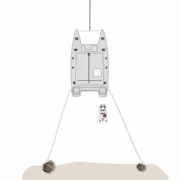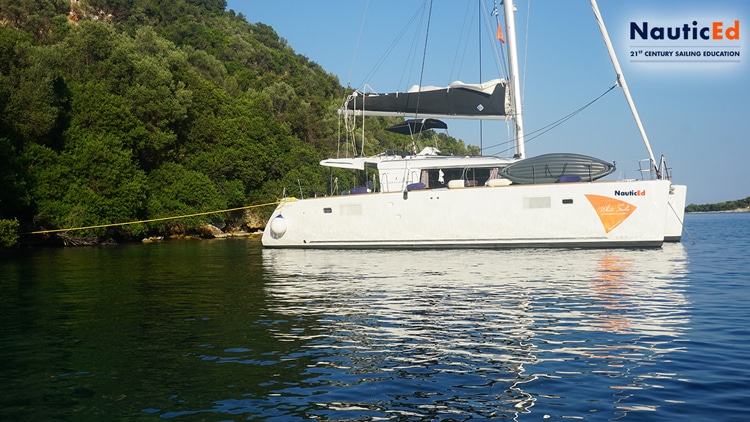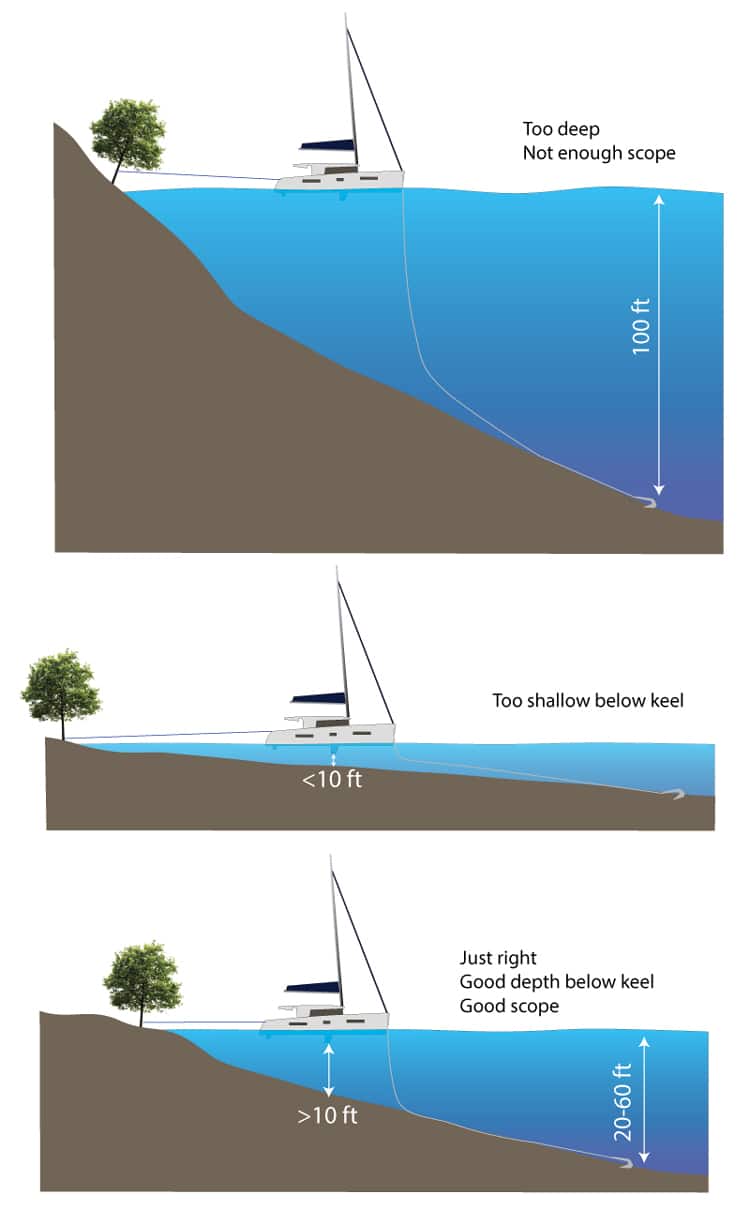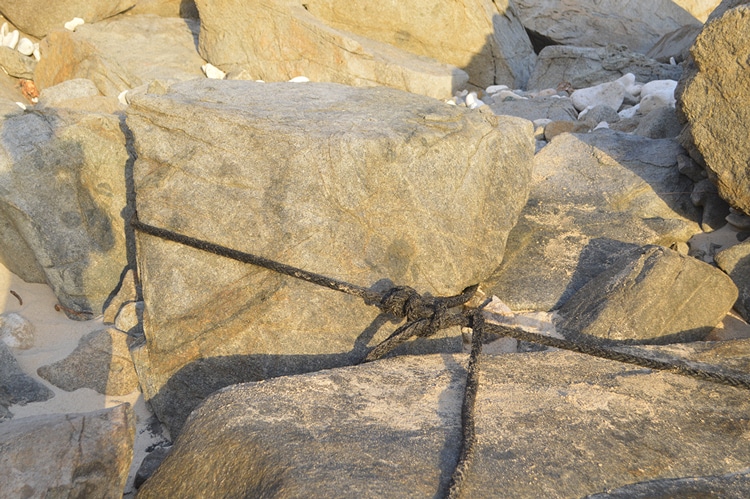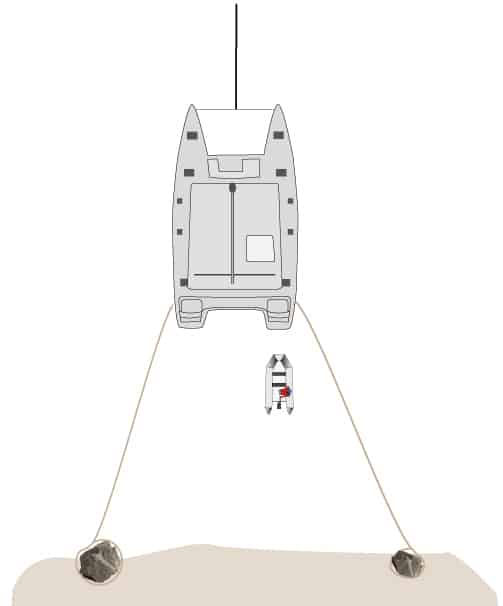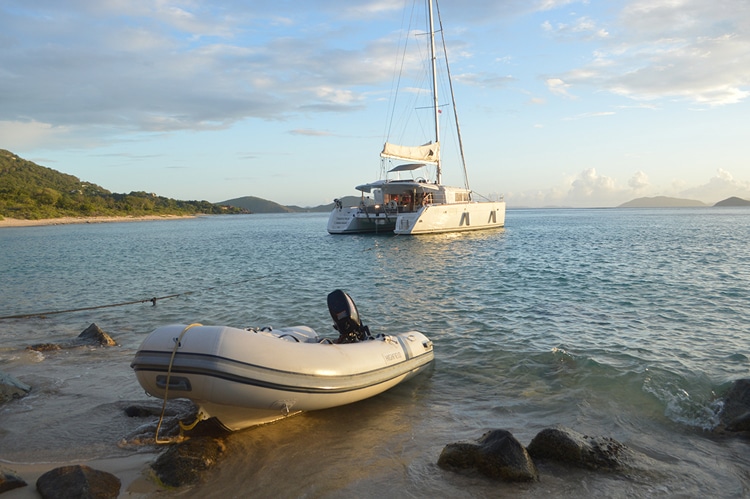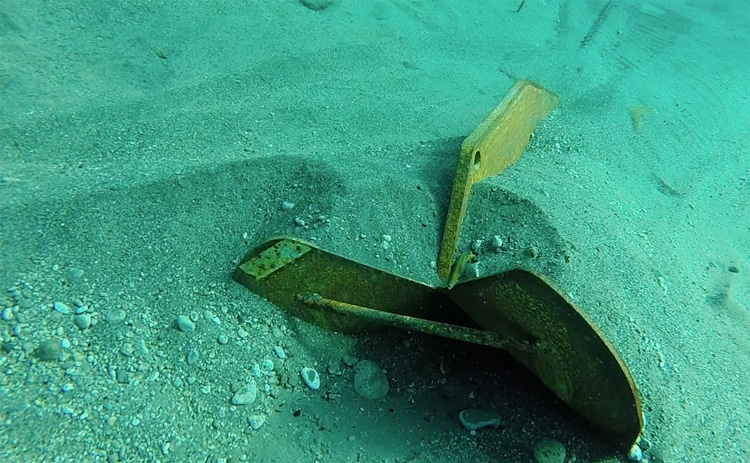Mediterranean Mooring – Long Line Ashore
The long-line-ashore is a useful mooring method. It is mostly used in the Mediterranean as a customary way of mooring a lot of boats along a shoreline. But, it can be equally useful anywhere, particularly when there is no dock or marina, and there is just an undeveloped shoreline.
Overly simplified, long-line-ashore mooring is when you drop your anchor close to the shore, back up, and secure lines from your stern to a fixed object on shore.
Here are some useful tricks and intricacies brought to you by our education partner, NauticEd International Sailing Education, that will make your long-line-ashore mooring much more successful.
The Setup
As with anything in life, the setup is the most important thing to ensure success.
(1) First, you have to select a suitable spot. There are a few things to consider when selecting a spot.
Depth. You’ll need to do a quick flyby to look at the depths at the anchor drop point and also near the shore. You can’t drop in too deep of water depth and you can’t have it so shallow that your rudder hits the bottom as you back towards the shore.
Tie-off. Next, look specifically at what is ashore that you can tie to. This might be a well-placed tree or a nicely shaped rock that you can tie to without the line slipping off.
Lines. It is ideal to have floating lines, but it is not necessary. Floating lines make it easier to get the lines ashore and it keeps them out of the propeller. The lines need to be long; longer than you think because at the final resting spot, you could be anywhere from 20 ft to 150 ft from the shore.
You can tie lines together to increase the length but again they need to be long. A couple of dock lines will probably not be sufficient. When setting out on a charter, make sure your charter company provides you with at least two long-lines.
Most likely, the long-lines will run at an angle to the shore outwards from the boat so don’t make the mistake of getting the long-lines on the wrong side of the stern pulpit.
Two lines ashore are best to prevent the boat from sideways movement with changing winds. If there is a cross-wind, the first long-line to tie ashore should be the windward line.
For very long lines, it is prudent to tie floaties of some sort onto the lines for visibility to others.
The Plan
Create a plan with the crew and fully communicate your expectations of their jobs. There are some important considerations:
- Is someone going to swim the long-line-ashore or will someone dinghy it ashore?
- What does the shore look like? Will the person tying the line need shoes for a rocky shore? Watch out for sea urchins!
- Who is the most efficient and competent person to do this?
- Can the person tie a bowline knot or round turn and two half hitches knot quickly without fail?
- Who will operate the anchor and do they know the intricacies of anchoring?
- What is the wind situation? Forward and stern winds are easy but side-winds require some maneuvering expertise. If the wind is blowing anything more than say 7 knots, you won’t have a lot of time to be mucking around — especially if the wind is abeam.
- Catamarans are more maneuverable than monohulls at holding a position on station.
There are two main methods to get the line ashore: swimming ashore or using a dinghy.
Swimming Ashore. While swimming ashore is fun and cool, the wind will be a deciding factor (besides water temperature). Swimming ashore takes time and it can be difficult for the helmsperson to stay on station at the final stopping point if the wind is across the beam. Use a strong swimmer who can tie a good knot. Think about feet protection on shore.
Once the boat has backed to its final resting place, the swimmer can take one end of the windward (if a crosswind exists) long-line (already cleated outside the stern pulpit) and swim it ashore. A crew member will need to help feed the outgoing long-line to the swimmer and report to the helmsperson the status of the long-line including ensuring it stays away from the prop. Once tied ashore, the boat crew will tighten up the long-line on the cleat.
The swimmer can then return to the boat and take the leeward (if a crosswind exists) long-line ashore and tie off.
Even if there is no crosswind, you should assume there might be a change in wind. Thus, two long-lines at an angle are always prudent.
Dinghy. If you are going to be using the dinghy to long-line-ashore, you have some flexibility based on the wind. You can either deploy the dinghy with all the long-line (not cleated to the boat) after the boat is in position or for more annoying wind directions, you can deploy the dinghy first (again, with all the long-line aboard and not cleated to the boat) before you drop the anchor.
For the annoying wind situation (a crosswind), start out by selecting the right mooring spot with good tie-off points selected. Stop the boat out and away from the selected mooring point and deploy the dinghy with the appropriate crew and with all the long-line in the dinghy. The dinghy crew will tie off to the selected windward shore point and bring the long-line back out to the final mooring spot of the boat. Once this is complete, the helmsperson can order the anchor to be dropped, maneuver the boat backwards to the dinghy, and cleat the long-line to the windward side of the boat. The dinghy crew then repeats the process for the leeward line ashore.
View this animation of using the dinghy to take a long-line ashore.
If the winds are friendly, it is ok to anchor and back the boat to its final position and then proceed with the dinghy operations. Again, a catamaran is easier to hold on station because of its maneuverability under power.
Once the long-lines and anchor are set, it is a good idea to tighten everything to prevent the wind from pushing the boat into other similarly moored boats alongside. To do this, put the boat in reverse and pull backward on the anchor, then re-cleat the long-lines. OR put the boat in forwards to tension the long-lines and use the windlass to tighten up on the anchor.
Finally, if possible, it is a really good idea to dive the anchor to make sure it is secure on the bottom and that a sufficient scope has been used.
The Anchoring Part of the Operation
It is very important to make sure the anchor is well secured to the bottom. You cannot afford for a side wind to break the anchor free and have the boat wash alongside the shore.
Scope. With all chain rode you should plan on letting out at least 50 feet (15m) plus 2 times the depth of chain if possible. There is an easy way to estimate this by using boat lengths as a measuring gauge as you look across the water. It is easier to envision 5 boat lengths than say 200 feet (65m).
If the water is 20 feet (6m) deep where you drop then you need 50 feet (15m) plus 2 times 20 feet (6m) = 90 ft (27m). For a 40 ft boat, you need a little more than 2 boat lengths minimum – allow 3 boat lengths.
If the water is 60 feet (18m) deep then you need 50 feet (15m) plus 2 times 60 feet (18m) = 170 ft (51m). For a 40 ft boat, you need a little more than 4 boat lengths – allow 5 if you can.
|
Anecdote: One time in Puerto Rico one of the boats in our flotilla had dropped anchor and was backing back to tie up alongside. They dropped the anchor a little too far forward and right before they got to us the end of the chain WHICH WAS NOT TIED TO THE BOAT went through the windlass and “plink” into the water. Fortunately, we had a navy Seal onboard, who could hold his breath for a very long time, was able to dive down and find the end of the chain (AT NIGHT) and tie a line with a floating buoy. Moral of the story? Always have a navy Seal on board – oh and check the end of the chain is tied to the boat. |
You can see that as the water gets deeper at the point of anchor drop, you may not have enough chain onboard. But still, you should not compromise that ratio. You may need to select another spot.
Pick the appropriate distance offshore to drop your anchor with your stern facing the shore. Deploy the anchor but do not start backing until your anchor person gives you the thumbs up that the anchor is on the bottom. Now, start backing. If you start earlier, you are already compromising your scope.
The anchor person must control the helmsperson’s speed of the boat so that the anchor is not dragging across the bottom. The anchor person must be briefed on this. The anchor chain should be dropping straight down. If using a rope anchor rode, the rope should not be taught as the boat backs. The anchoring person can give slow-down signals or keep backing signals as needed.
Once on station at the final mooring spot, the helmsperson signals to the anchor person to stop paying out the rode and to take up the slack. The helmsperson can leave the boat in slight reverse to stay on station with the anchor rode taught until the long-line operations are complete.
Tides
All of the above is predicated on knowing and taking into account the tidal situation. As the tide changes height, you may need to tighten or loosen the anchor rode or the shore long-lines. Also ensure that as the tide rises, you have taken into account the associated change in scope.
Short Handed Method
If you’re short on crew, there is a good way to easily accomplish the long-line ashore mooring method.
After you have selected your final resting spot, you or a crew member can take the dinghy and the long-line to the shore and tie the long-line to the shore (tree or rock). Make this your windward line. Bring the dinghy back out and tie a floaty and a bucket on the free end of the line. This will keep the free end situated in approximately the right place for enough time to complete the remainder of the operation.
Now go back to the boat, drop the anchor in the selected spot, and back up to your floaty and bucket. Bring the free end on the boat and cleat off. Tension the anchor a little to hold station and then take your time getting the leeward long-line ashore and back to your boat. Cleat off and tension the anchor more.
Long-Line Ashore Summary
Mastering the long-long-ashore mooring method is vital for boat ownership or chartering anywhere, especially in the Mediterranean. Practice at home or with your sailing school using the steps above.


